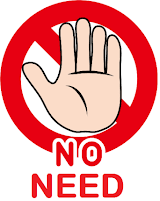How to Address Sales Objections
Sales objections are simply indications that a consumer isn’t ready nor willing to buy from you for a certain reason. They can come in all shapes and sizes.
However, that doesn’t
mean your job is done. There are many ways to deal with sales objections and here
are a few examples and some good ways to approach and overcome them.
Sometimes a
buyer just doesn’t see the purpose of a product or service. Perhaps they don’t recognise
the problem you’re offering to solve or maybe they can’t grasp the full value
your product has.
How do you sell
to a customer like this? You could:
·
Learn
more about this potential customer.
o
You
just might discover a way that your product fits into their life
·
Take
your time.
o
There’s
no need to rush and by gathering more information, you’ll find even more
reasons this client might need a product in their life.
·
Talk
about the destination and not the journey.
o
Why
waste time talking about the process when talking about the result will have
more of an impact?
o
This
will add more perceived value to your product/service.
·
Use
figures.
o
Especially
for B2B companies, figures and statistics can go a long way when convincing
someone that they need what you have.
They can’t afford it
Probably the
most common objection is that consumers just can’t fit your product into their
budget. However, this objection could also be a mask for another concern of
theirs so it’s important to identify if the client’s reasoning is genuine.
But to handle a
customer lacking in funds you can always try:
·
Being
flexible.
o
There’s
no need to make ultimatums and scare off a potential customer.
o
Try
to find out what part of your service they don’t require and maybe you’ll be
able to find some wiggle room to cut them a deal.
o
Maybe
you could even convince them to pay in instalments instead of one large lump
sum.
·
Reminding
them of the value your product holds.
o
Convince
your customer that what you’re selling is worth the price.
o
Justify
why they should rethink their budget for your product.
Product Objection
Sometimes a
consumer may object to your product as a whole. They may compare it to a
similar product from a competitor of yours or think that yours is just missing
something or more complicated than what they’re looking for.
To combat this,
remember to use:
·
Anecdotal
evidence.
o
Try
to fit in testimony given by previous clients to explain how others have used
your product and what they found useful about it.
·
Descriptions
of your product.
o
Mention
the features, unique selling points, and policies.
o
If
necessary and possible then you could even demonstrate it for them.
o
Bring
up third party research if it helps to support your claim.
They don’t trust you
It’s common for
people to be wary of companies and products when there are so many snake oil
salesmen out there.
Even if they
feel they need what you’re offering, consumers might still be sceptical that
you can fulfil your promises. In cases, you should:
·
Be
honest and transparent
o
No
one is going to trust someone who praises their product to the extent of non-stop
hyperbole.
o
While
you should still present your product in a good light (and even better than
your competitors’) try to stay grounded in your approach to avoid coming off as
a “ShamWow” salesman.
4 basic steps to overcome an objection
In general, you
should always try to stick to the 4 basic steps when dealing with any type of
objection.
1. Listen
o
Don’t
just wait for your client to finish talking about their concerns. Do your best
to actually listen and take into account what they’re saying.
o
Automatically
responding with an answer or even interrupting them will only result in them
assuming you’re just following a script and may even give them a reason to trust
you less.
2.
Understand
o
As
was mentioned earlier, sometimes a customer will use one objection to cover
their true objections. By understanding what they’re saying, it’s likely you’ll
find out what barrier is truly stopping them from buying from you.
3. Respond
o
Regardless
of your own feelings on the matter, acknowledge what they’re saying. If they
don’t feel they are being taken seriously it’s unlikely a sale will be made.
o
If
you have permission, it’s ok to make changes to your offer to better fit their
needs.
4. Confirm
o
Go
over what you both have discussed and confirm with the client that you’ve both
overcome whatever hurdles they had and that they are content with the deal you’ve
struck.
o
After
all, there’s no point in overcoming their objection if it still doesn’t result
in a sale.
With these examples and tips, hopefully, you now have a good grasp of how to deal with sales objections.
Visit
ExcelifySolutions.com for more information or click any of the links below to
be sent to our pages on social media.
Now go out
there and put these tips to good use!












Comments
Post a Comment